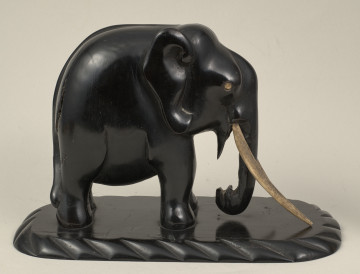
A figurine of an elephant
XIX century
Castle Museum in Łańcut
Part of the collection: Rzeźby
For Christians, the cross is a sign of redemption and God's love for man. The sign of the cross begins and ends the services, it is performed by blessing e.g. the faithful at the end, the food in the Easter basket. Until recently, it was a common tradition to make the sign of the cross on a loaf before cutting the first slice. Parents bless their children with the sign of the cross in the rite of baptism or marriage.
Crucifixion was the most heinous and cruel death penalty to which the greatest criminals were condemned. That is why in the first centuries Christians used the sign of the fish, and it was not until the fourth century A.D. that it was replaced by the cross in the Latin form. The cross, through its vertical beam, symbolizes the connection between earth and heaven, between God and man, while the horizontal beams symbolize the arms of Christ, who redeemed the whole world through death.
From the early Middle Ages, a figure of the crucified Christ began to be placed on the cross. It is often accompanied by symbols of the Passion and a tablet with the Latin abbreviation INRI - Iesus Nazarenus rex Iudaeorum – Jesus the Nazarene, King of the Jews. The Latin cross with the figure of Christ placed on it is a crucifix, from the Latin "cruci fixus" – nailed to the cross.
The motif of the cross is strongly rooted in culture and art, as exemplified by the crucifix from our collection. It was made in France in the eighteenth century. This is an example of an altar cross made of wood. Attention is drawn to the ivory figure of Christ. It was made of ivory. The precision with which the entire figure was sculpted, especially the feet, hands, head with a crown of thorns or perizonium, testifies to the extraordinary talent of the author. The immensity of suffering emanates from the face of Christ, which additionally prompts the viewer to reflect more deeply and pray deeply.
Anna Szczęsny
Object type
rzeźba
Material
Ivory
Creation time / dating
Owner
Muzeum - Zamek w Łańcucie
Identification number
Location / status

XIX century
Castle Museum in Łańcut

XIX century
Castle Museum in Łańcut

20th century
Castle Museum in Łańcut
DISCOVER this TOPIC
Museum of King Jan III's Palace at Wilanów
DISCOVER this PATH
Educational path